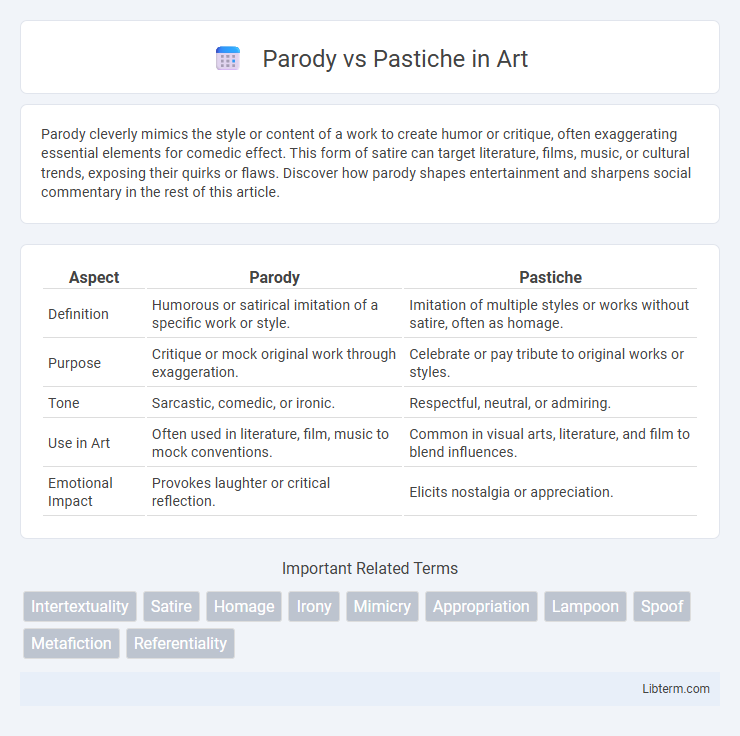Parody cleverly mimics the style or content of a work to create humor or critique, often exaggerating essential elements for comedic effect. This form of satire can target literature, films, music, or cultural trends, exposing their quirks or flaws. Discover how parody shapes entertainment and sharpens social commentary in the rest of this article.
Table of Comparison
| Aspect | Parody | Pastiche |
|---|---|---|
| Definition | Humorous or satirical imitation of a specific work or style. | Imitation of multiple styles or works without satire, often as homage. |
| Purpose | Critique or mock original work through exaggeration. | Celebrate or pay tribute to original works or styles. |
| Tone | Sarcastic, comedic, or ironic. | Respectful, neutral, or admiring. |
| Use in Art | Often used in literature, film, music to mock conventions. | Common in visual arts, literature, and film to blend influences. |
| Emotional Impact | Provokes laughter or critical reflection. | Elicits nostalgia or appreciation. |
Understanding Parody: Definition and Key Features
Parody is a creative work that humorously imitates the style, tone, or content of an original piece to highlight its peculiarities or criticize it, often through exaggeration or satire. Key features of parody include recognizable mimicry, comedic intent, and critical engagement with the source material, making it distinct from other imitative forms. Understanding parody involves recognizing its dual function as both an homage and a critique, using irony and exaggeration to convey meaning.
What is Pastiche? Exploring Its Core Elements
Pastiche is a literary or artistic work that imitates the style, tone, or content of one or more other works, often celebrating their distinctive features rather than mocking them. Its core elements include homage, stylistic imitation, and a blend of multiple influences to create a composite work that respects the original sources. Unlike parody, pastiche avoids satire and instead embraces the source material with reverence and creativity.
Historical Origins: Parody and Pastiche in Literature
Parody originated in ancient Greek literature as a form of satirical imitation, often used by playwrights like Aristophanes to critique societal issues through humor and exaggeration. Pastiche, emerging prominently in 18th-century European literature, involves the respectful imitation of various styles or authorship to celebrate or pay homage rather than to mock. Both literary techniques evolved as distinctive methods for engaging with and reinterpreting existing works, reflecting cultural and artistic dialogues across history.
Techniques Used in Creating Parody
Parody employs techniques such as exaggeration, irony, and satire to mimic and critique the style or content of an original work, enhancing humor and social commentary. It often utilizes imitation of tone, dialogue, and character traits to expose flaws or inconsistencies in the source material. These techniques distinguish parody from pastiche, which replicates style without the intention of ridicule or critique.
Stylistic Approaches in Pastiche Writing
Pastiche writing employs stylistic mimicry by deliberately imitating the tone, structure, and linguistic nuances of a particular author or genre to pay homage rather than mock, distinguishing it from parody's satirical intent. It involves blending multiple sources or styles seamlessly, creating a layered narrative that celebrates the original works' artistic elements. The technique emphasizes authenticity in replication, often highlighting admiration for the source material through careful attention to detail and stylistic precision.
Purpose and Intent: Parody vs Pastiche
Parody serves the purpose of humorously critiquing or mocking the original work, often highlighting its flaws or idiosyncrasies through exaggeration and satire. Pastiche, on the other hand, aims to celebrate or pay tribute to the original style or genre by imitating it respectfully, without the intent to ridicule. The intent behind parody is to provoke thought and entertain through mockery, while pastiche seeks to honor and replicate the aesthetic qualities of the source material.
Examples of Parody in Popular Culture
Examples of parody in popular culture include "Weird Al" Yankovic's music that humorously mimics famous songs, "Saturday Night Live" sketches that satirize political figures, and the film "Scary Movie," which mocks common horror movie tropes. These parodies exaggerate original works to create comedic effect while providing social commentary. Parody openly critiques or ridicules the source material, distinguishing it from pastiche's imitative but respectful homage.
Noteworthy Instances of Pastiche in Art and Media
Noteworthy instances of pastiche in art and media include Quentin Tarantino's films, which blend elements from various genres and eras to create homage-infused narratives, and Picasso's "Les Demoiselles d'Avignon," which integrates African tribal art influences. In literature, Michael Chabon's "The Amazing Adventures of Kavalier & Clay" uses pastiche to evoke the golden age of comic books, while in music, artists like Beck fuse multiple styles to pay tribute to past music trends. These examples highlight pastiche's role in celebrating and recontextualizing existing artistic forms without the satirical edge characteristic of parody.
Impact on Audience: Interpreting Parody and Pastiche
Parody often engages the audience by using humor and satire to critique or mock the original work, prompting viewers to question underlying themes and societal norms. Pastiche, by imitating styles without critical intent, evokes nostalgia and appreciation, allowing the audience to celebrate the original art form's aesthetics and cultural significance. Both forms influence interpretation, with parody fostering critical reflection and pastiche encouraging homage and affection toward source material.
Parody and Pastiche in Contemporary Creative Works
Parody in contemporary creative works functions as a satirical tool that humorously critiques or mocks original styles and cultural phenomena by exaggerating distinctive features. Pastiche, conversely, is used to celebrate and imitate multiple artistic styles without mocking, often blending genres to pay homage to past influences. Both techniques thrive in modern media, influencing films, literature, and digital art by either provoking thought through irony or fostering appreciation through eclectic synthesis.
Parody Infographic

 libterm.com
libterm.com